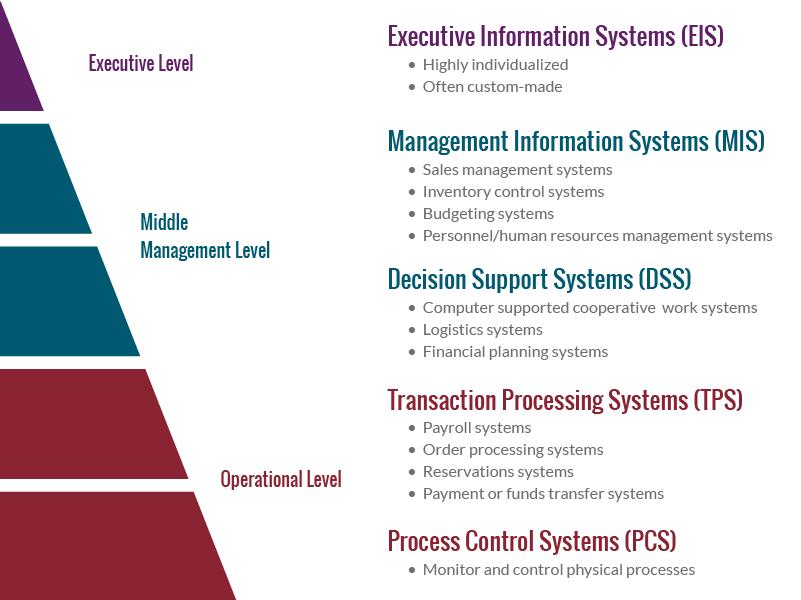Imagine working for a large coffee shop chain. From the number of orders taken per day at one store to the overall company’s quarterly performance, data must be processed and analyzed at all levels of the organization for managers to make sound decisions. If you’re a store manager, inventory information may be what you need to decide what product to order more of. As a chief executive, having an overall picture of the company performance could be the information you require to evaluate diversification strategies. How can this information be stored and classified so that you can make the decisions you need to as a manager?
The Pyramid Model for Classifying Information
One of the most widely-used systems for classifying different information systems is known as the pyramid model. The pyramid model classifies information based on the tasks and responsibilities that are found in a hierarchical organization. Think of a hierarchical organization as a pyramid that can be divided into three levels: operational level, middle management level and executive, or senior, level.
Managers residing at these three levels have different information needs and consequently utilize information systems that satisfy their specific information needs. Within these three levels are five types of information systems.

Operational Level
Operations managers run the day-to-day business operations and make routine decisions such as a coffee shop manager wanting to know whether to order more coffee or not for next week. Transaction processing systems and process control systems are two types of information systems used at the operational level.
1. Transaction Processing System
Operational managers use transaction processing systems that can track and capture automated or semi-automated transactions between an employee and a customer, an employee and a supplier, or even between two employees of different departments within the same organization. The main job of a transaction processing system is to validate, sort, merge, calculate and update data from these transactional events and produce summary reports or lists from which decisions can be made.
Examples of transaction processing systems include:
- Payroll systems
- Order processing systems
- Reservation systems
- Systems for payments and fund transfers
2. Process Control Systems
Another kind of system that can be used at the operational level are process control systems. Process control systems are used to monitor and control physical processes. An example would be to test the temperature of food as it’s being prepared. Unlike transaction processing systems, process control systems take their input data from sensors to generate reports that are analyzed by an operational manager to adjust the business process.
Examples of process control systems include:
- Assembly lines
- Petroleum refineries
Middle Management Level
Middle-level managers make tactical decisions that assist in implementing the strategy of the organization. Tactical decisions involve decisions related to developing divisional plans, structuring workflows, establishing distribution channels and acquisition of resources, such as personnel, materials and money. For the coffee shop example, a tactical decision would be whether to open earlier in the morning or on the weekends to attract new customers. Two types of information systems that can be used by middle-level managers are management information systems and decision support systems.
3. Management Information Systems
Management information systems are built on data provided by transaction processing systems. They extract their data from databases located in different departments to compile reports such as sales analysis, inventory level reports, or financial statements. They typically have little or no analytical capability and are used to provide reports on the firm’s past or current performance rather than the future performance of an organization.
Examples of management information systems include
- Sales management systems
- Inventory control systems
- Budgeting systems
- Human resource management systems
4. Decision Support Systems
Decision support systems, on the other hand, are interactive systems that can be seen to solve ill-structured or semi-structured problems. An example of an ill-structured problem for the coffee shop would be whether to open a new coffee shop at another location. Decision support systems have analytical and/or modeling capabilities to analyze existing structured information and they allow managers to project the potential effects of their decisions into the future. They may also support the exchange of information within the organization, so they are also classified as knowledge management systems.
Examples of decision support systems include
- Group decision support systems
- Computer-supported cooperative work systems
- Logistics systems
- Financial planning systems
Executive Level
The top-most level is the senior executive level, also known as the C-suite level because management at this level is comprised of CEOs, COOs, CIOs, CFOs, etc. The C-suite makes strategic decisions that affect and shape the future survivability of an organization. An example of a strategic decision for the coffee shop would be to decide whether to remain in the café business or not. Long-term forecasts of business turnover set against likely market conditions can help the senior management of the coffee shop determine whether they should close the café business or not.
5. Executive Information Systems
Executive information systems help executives and other senior managers analyze the environment in which the organization operates to identify long-term trends and to plan appropriate courses of action. The information in such a system is often weakly structured and comes from both internal sources, such as its own databases or data warehouse, and external sources, such as data from customers, suppliers, or other governmental databases.
Executive information systems tend to be highly individualized and are often custom-made for a particular client group. However, many off-the-shelf executive information systems packages do exist. And many enterprise-level systems offer a customizable executive information system module. An easy to use digital dashboard with a real-time view of the performance of an organization is a common feature of an executive information system.
Information systems are one of the many industry topics explored in Florida Tech’s information technology degree programs. Learn more about these programs here.

